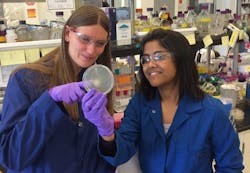Better Biofuel Process Beckons
A process that uses engineered bacteria to streamline production could make biofuels a viable competitor to fossil fuels, believe researchers at the U.S. Department of Energy (DOE) Lawrence Berkeley National Laboratory (Berkeley Lab), Berkeley, Calif.
Figure 1. Marijke Frederix (left) and Aindrila Mukhopadhyay conducted work in a microbiology lab at the Joint BioEnergy Institute. Source: Irina Silva/JBEI, Berkeley Lab.
The E. coli they engineered tolerates the liquid salt (ionic liquids) used to deconstruct plant biomass into sugary polymers. The bacteria eliminates the need to remove the liquid salt, as ordinarily is required, allowing a one-pot method for producing advanced biofuels.
“Being able to put everything together at one point, walk away, come back, and then get your fuel, is a necessary step in moving forward with a biofuel economy,” says the study’s principal investigator Aindrila Mukhopadhyay, vice president of the Fuels Synthesis Division at the Joint BioEnergy Institute (JBEI), a DOE Bioenergy Research Center at Berkeley Lab. “The E. coli we’ve developed gets us closer to that goal.”
[javascriptSnippet ]
Marijke Frederix, a postdoctoral researcher in Mukhopadhyay’s lab, discovered that a gene mutation leads to the E. coli strain highly tolerant to ionic liquids. The two researchers tested the strain on ionic-liquid pretreated switchgrass. An article in Green Chemistry includes more detail.
Because they did not use pure sugars, the yields were significantly lower than other biofuel production processes; however, “we anticipate that we can improve production back to high levels with various optimizations,” notes Mukhopadhyay.
“Having strains with the greatest yields and rates of production are always our desired goals. We did not examine rates in our study. But, being able to reduce the number of ‘pots’ or unit operations in the whole process from renewable biomass to fuel is definitely a major source of cost reduction,” she adds.
“Currently, we have only engineered the strain to digest cellulose so it can use the resulting glucose to grow and make the biofuel,” explains Mukhopadhyay. “We can also engineer it to digest hemicellulose, another large component of plant biomass so that it can use the resulting xylose for growth and production also!”
In addition, the researchers plan to address the issue of other potentially inhibiting compounds in the growth medium, and the toxicity of the final product that could also negatively impact fuel production.
Another potential challenge is understanding how to synergistically combine different tolerance mechanisms. “The way we would like to do this is by making the regulation of these systems more dynamic,” explains Mukhopadhyay. “That is, rather than have all of these systems ‘on’ at all times or on in a static manner we want to develop modules where each mechanism is regulated in a dynamic manner and is ‘on’ only when needed. We have previously published studies to show that this can be done… Now we will test if we can really use such strategies to develop a microbial platform where all of these mechanisms can be used in a synergistic manner.” In addition, Mukhopadhyay notes that using the lignin component of biomass is a grand challenge in obtaining the best bioconversion process.
Many of their one-pot systems are in advanced stages of development. “Thanks to several collaborative efforts within JBEI and with external partners and user facilities like the DOE ABPDU (Advanced Biofuels Process development Unit), we should be able to test some of these soon [on a larger laboratory and pilot-plant scale],” says Mukhopadhyay.
“From a process point of view it would be great to work with technologists and process engineers to improve the separation of the biofuel and bioproducts from the cultivation broth. This is worked out for some compounds, but not optimized for many,” she concludes.

